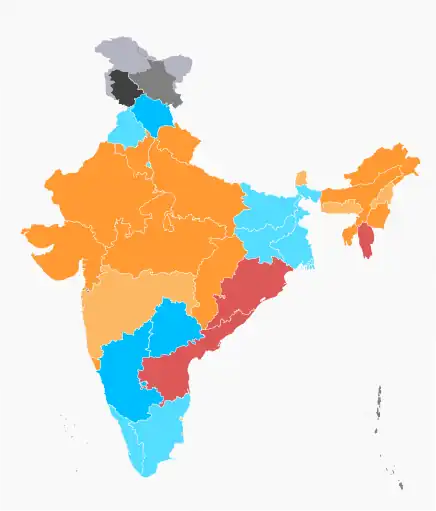| This article is part of a series on the |
| Politics of India |
|---|
 |
|
|
The State Legislative Assembly, or Vidhan Sabha,[1] also called Saasana Sabha, is a legislative body in each of the states and certain union territories of India. In 22 states and 3 union territories, there is a unicameral legislature which is the sole legislative body. In 6 states, the legislative assembly is the lower house of their bicameral legislature with the upper house being the State Legislative Council. 5 union territories are governed directly by the Union Government of India and have no legislative body.
Each Member of the Legislative Assembly (MLA) is directly elected to serve 5-year terms by single-member constituencies. The Constitution of India states that a State Legislative Assembly must have no less than 60 and no more than 500 members however an exception may be granted via an Act of Parliament as is the case in the states of Goa, Sikkim, Mizoram and the union territory of Puducherry which have fewer than 60 members. A State Legislative Assembly may be dissolved in a state of emergency, by the Governor on request of the Chief Minister, or if a motion of no confidence is passed against the ruling majority party or coalition.[2]
Member of Legislative Assembly
To become a member of a State Legislative Assembly, they must have their name in the voters' list of the state for which they are contesting an election. They may not be a Member of Parliament and Member of the State Legislative Council at the same time. They should also state that there is no criminal procedures against him or her. A State Legislative Assembly holds equal legislative power with the upper house of the state legislature, the State Legislative Council, except in the area of dissolution of state government and passing of money bills, in which case the State Legislative Assembly has the ultimate authority.
Powers of legislative assemblies are given down below:
- A motion of no confidence against the government in the state can only be introduced in the State Legislative Assembly. If it is passed by a majority vote, then the Chief Minister and her/his Council of Ministers must collectively resign.
- A money bill can only be introduced in State Legislative Assembly. In bicameral jurisdictions, after it is passed in the State Legislative Assembly, it is sent to the State Legislative Council, where it can be kept for a maximum time of 14 days.
- In matters related to ordinary bills, the will of the State Legislative Assembly prevails and there is no provision of joint sitting. In such cases, State Legislative Council can delay the legislation by a maximum of 4 months (3 months in the first visit and 1 month in the second visit of the bill).
- Legislative Assembly of the state has the power to create or abolish the State Legislative Council by passing a resolution to that effect by a majority of not less than two-thirds of the members present and voting.[3]
Current State Legislative Assemblies
State Legislative Assemblies by ruling parties

The Bharatiya Janata Party led National Democratic Alliance is in power in 17 legislative assemblies; the Indian National Developmental Inclusive Alliance is in power in 10 legislative assemblies; 3 legislative assemblies are ruled by other parties/alliances; and 5 union territories do not have a legislative assembly. The newly formed Union territory of Jammu and Kashmir has not had elections to form a government and President's rule has been imposed there.
Former State Legislative Assemblies
| Assembly | Seat | Period active | Abolished by |
|---|---|---|---|
| Ajmer Legislative Assembly | Ajmer | 1950–1956 | States Reorganisation Act, 1956. |
| Bombay Legislative Assembly | Bombay | 1950–1960 | Bombay Reorganisation Act, 1960. |
| Coorg Legislative Assembly | Mercara | 1950–1956 | States Reorganisation Act, 1956. |
| Hyderabad Legislative Assembly | Hyderabad | 1952–1956 | States Reorganisation Act, 1956. |
| PEPSU Legislative Assembly | Patiala | 1950–1956 | States Reorganisation Act, 1956. |
See also
References
- ↑ "Vidhan_Sabha". Collins English Dictionary. HarperCollins Publishers. 2014.
- ↑ "State Legislative Assemblies" (PDF). www.india.gov.in. Retrieved 12 December 2018.
- ↑ "Explainer: Why Jagan Reddy wants to abolish the legislative council in Andhra Pradesh". The Week.
- ↑ "Terms of the Houses". Election Commission of India. Retrieved 28 August 2022.
- ↑ "Explained: The 38 parties in the NDA fold". The Indian Express. 19 July 2023. Retrieved 25 July 2023.
- ↑ Ghosh, Sanchari (19 July 2023). "INDIA from UPA: Opposition's push for a new name explained". mint. Retrieved 25 July 2023.
External links
- Legislative Bodies in India website
- Laws of India website to download laws made by different states


